Acute Oak Decline
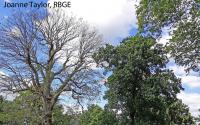
|
- Acid grassland
- Boundary and linear features
- Bracken
- Broadleaved, mixed and yew woodland
- Built up areas and gardens
|
|
NOTIFIABLE SYNDROME
Forest Research fact sheet
Forest Research fact page
Forest Research poster
James Hutton Institute ecological impacts
Observatree fact page
RHS fact page
Woodland Trust fact page
|
|
Alder Rust (Melampsoridium hiratsukanum)
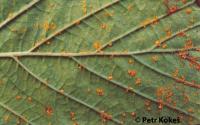
|
- Broadleaved, mixed and yew woodland
|
- Alnus (Alder)
- Betula (Birch)
|
NOBANIS – Invasive Alien Species Fact Sheet
|
|
Ash Dieback (Hymenoscyphus fraxineus)
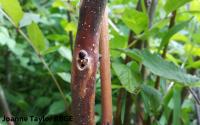
|
- Boundary and linear features
- Bracken
- Broadleaved, mixed and yew woodland
|
|
NOTIFIABLE ORGANISM if found in previously unconfirmed area
Observatree fact page
Observatree Toolkit
Forestry Commission fact page
Forest Research poster
Forest Research fact sheet
James Hutton Institute ecological impacts
RHS fact page
The Tree Council Ash Dieback Toolkit
|
|
Asian Longhorn Beetle (Anoplophora glabripennis)
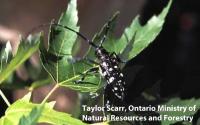
|
- Bogs
- Boundary and linear features
- Bracken
- Broadleaved, mixed and yew woodland
- Built up areas and gardens
- Calcareous grassland
- Coniferous woodland
- Dwarf shrub heath
- Fen, marsh and swamp
- Inland rock
- Littoral sediment
- Montane habitats
- Rivers and streams
- Standing open water and canals
- Supralittoral rock
- Supralittoral sediment
|
- Acer (Maple, Sycamore)
- Betula (Birch)
- Populus (Poplar, Aspen)
- Salix (Willow)
|
NOTIFIABLE ORGANISM
Forest Research fact page
Opal fact page
Observatree fact page
RHS fact page
Woodland Trust fact page
|
|
Black Timber Bark Beetle (Xylosandrus germanus)
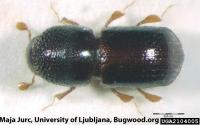
|
- Acid grassland
- Boundary and linear features
- Bracken
- Broadleaved, mixed and yew woodland
- Built up areas and gardens
- Calcareous grassland
- Coniferous woodland
- Dwarf shrub heath
- Fen, marsh and swamp
- Inland rock
- Littoral sediment
- Montane habitats
- Rivers and streams
- Standing open water and canals
- Supralittoral rock
- Supralittoral sediment
|
- Acer (Maple, Sycamore)
- Alnus (Alder)
- Betula (Birch)
- Carpinus (Hornbeam)
- Castanea (Sweet Chestnut)
- Fraxinus (Ash)
- Pine (Pinus)
- Populus (Poplar, Aspen)
- Prunus (Blackthorn, Damson)
- Quercus (Oak)
- Salix (Willow)
- Ulmus (Elm)
|
CABI data sheet
Natural Resources Canada fact page
|
|
Bronze Birch Borer (Agrilus anxius)
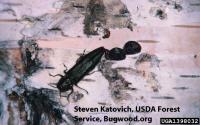
|
- Bogs
- Boundary and linear features
- Broadleaved, mixed and yew woodland
- Coniferous woodland
- Dwarf shrub heath
- Inland rock
|
|
NOTIFIABLE ORGANISM
DAERA fact page
Observatree fact page
|
|
Canker of Conifers (Gremmeniella abietina)
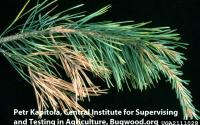
|
- Bogs
- Broadleaved, mixed and yew woodland
- Coniferous woodland
- Montane habitats
|
|
CABI data sheet
CIFA fact sheet
|
|
Chestnut Blight (Cryphonectria parasitica)
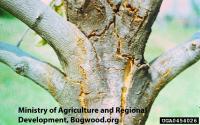
|
- Broadleaved, mixed and yew woodland
|
- Castanea (Sweet Chestnut)
|
NOTIFIABLE ORGANISM
CABI data sheet
Forest Research fact page
Woodland Trust fact page
Observatree fact page
|
|
Citrus Longhorn Beetle (Anoplophora chinensis)
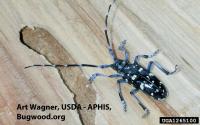
|
- Bogs
- Boundary and linear features
- Bracken
- Broadleaved, mixed and yew woodland
- Built up areas and gardens
- Calcareous grassland
- Coniferous woodland
- Dwarf shrub heath
- Fen, marsh and swamp
- Inland rock
- Littoral sediment
- Montane habitats
- Rivers and streams
- Standing open water and canals
- Supralittoral rock
- Supralittoral sediment
|
- Acer (Maple, Sycamore)
- Aesculus (Horse Chestnut)
- Alnus (Alder)
- Betula (Birch)
- Carpinus (Hornbeam)
- Corylus (Hazel)
- Crataegus (Hawthorn)
- Fagus (Beech)
- Malus (Apple)
- Populus (Poplar, Aspen)
- Prunus (Blackthorn, Damson)
- Rose (Rosa)
- Salix (Willow)
- Ulmus (Elm)
|
NOTIFIABLE ORGANISM
DEFRA fact sheet
NRW fact page
NNSS fact page
Observatree fact page
OPAL fact page
RHS fact page
Scottish Government fact page
|
|
Conifer Root and Butt Rot (Heterobasidium annosum)
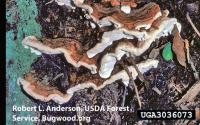
|
- Broadleaved, mixed and yew woodland
- Coniferous woodland
|
|
Forest Research fact page
First Nature fact page
|
|
Dothistroma Needle Blight (Dothistroma septosporum)
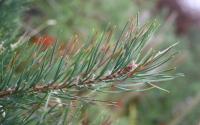
|
- Bogs
- Broadleaved, mixed and yew woodland
- Coniferous woodland
- Montane habitats
|
|
Forest Research field guide
Forestry Commission fact sheet
Forest Research poster
Forest Research fact page
Observatree fact page
Woodland Trust fact page
|
|
Dutch Elm Disease (Ophiostoma novo-ulmi)
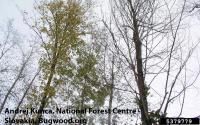
|
- Broadleaved, mixed and yew woodland
|
|
Forest Research fact page
Forest Research fact sheet
Forest Research pathology note
Forestry Commission Research Information Note 252
RHS fact page
|
|
Elm Zig Zag Sawfly (Aproceros leucopoda)
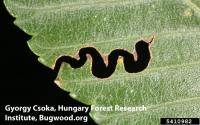
|
- Broadleaved, mixed and yew woodland
|
|
Forest Research fact page
|
|
Emerald Ash Borer (Agrilus planipennis)
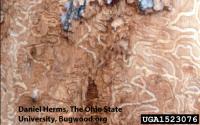
|
- Boundary and linear features
- Bracken
- Broadleaved, mixed and yew woodland
|
|
NOTIFIABLE ORGANISM
Forest Research fact page
Observatree fact page
Woodland Trust fact page
DAERA fact page
EAB Information network
|
|
Fire Blight (Erwinia amylovora)
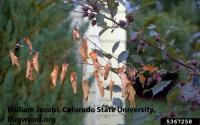
|
- Bogs
- Boundary and linear features
- Bracken
- Broadleaved, mixed and yew woodland
- Built up areas and gardens
- Coniferous woodland
- Inland rock
- Montane habitats
|
- Crataegus (Hawthorn)
- Malus (Apple)
- Prunus (Blackthorn, Damson)
- Rose (Rosa)
- Rubus (Blackberry)
- Sorbus (Rowan)
|
NOTIFIABLE ORGANISM
RHS fact page
CABI data sheet
|
|
Golden Root Mealy Bug (Chryseococcus arecae)
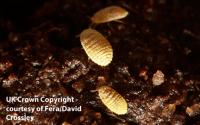
|
- Acid grassland
- Bogs
- Boundary and linear features
- Bracken
- Broadleaved, mixed and yew woodland
- Calcareous grassland
- Coniferous woodland
- Dwarf shrub heath
- Fen, marsh and swamp
- Improved grassland
- Inland rock
- Littoral sediment
- Montane habitats
- Neutral grassland
- Supralittoral rock
- Supralittoral sediment
|
- Primula (Primrose)
- Erica (Heath)
|
RHS fact page
|
|
Great Spruce Bark Beetle (Dendroctonus micans)
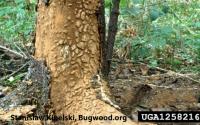
|
- Bogs
- Broadleaved, mixed and yew woodland
- Coniferous woodland
- Montane habitats
|
|
CABI data sheet
Forestry Commission fact sheet
Forest Research pest management fact page
NRW fact page
Observatree fact sheet
Observatree fact page
|
|
Gypsy Moth (Lymantria dispar)
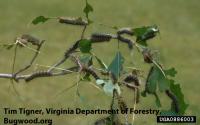
|
- Acid grassland
- Bogs
- Boundary and linear features
- Bracken
- Broadleaved, mixed and yew woodland
- Built up areas and gardens
- Calcareous grassland
- Coniferous woodland
- Dwarf shrub heath
- Fen, marsh and swamp
- Inland rock
- Littoral sediment
- Montane habitats
- Rivers and streams
- Standing open water and canals
- Supralittoral rock
- Supralittoral sediment
|
- Acer (Maple, Sycamore)
- Betula (Birch)
- Malus (Apple)
- Prunus (Blackthorn, Damson)
- Quercus (Oak)
- Salix (Willow)
- Ulmus (Elm)
|
Forest Research fact page
|
|
Honey fungus (Armillaria spp)
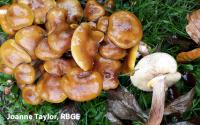
|
- Acid grassland
- Boundary and linear features
- Bracken
- Broadleaved, mixed and yew woodland
- Built up areas and gardens
- Calcareous grassland
- Coniferous woodland
- Dwarf shrub heath
- Fen, marsh and swamp
- Inland rock
- Littoral sediment
- Montane habitats
- Rivers and streams
- Standing open water and canals
- Supralittoral rock
- Supralittoral sediment
|
- Acer (Maple, Sycamore)
- Aesculus (Horse Chestnut)
- Betula (Birch)
- Fagus (Beech)
- Ilex (Holly)
- Malus (Apple)
- Pine (Pinus)
- Prunus (Blackthorn, Damson)
- Quercus (Oak)
- Rose (Rosa)
- Salix (Willow)
- Sorbus (Rowan)
|
Forestry Commission fact sheet
RHS fact page
First Nature fact page
|
|
Horse Chestnut Bleeding Canker (Pseudomonas syringae pv. aesculi)
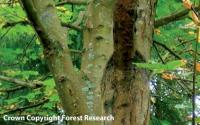
|
- Broadleaved, mixed and yew woodland
|
- Aesculus (Horse Chestnut)
|
Forest Research fact page
Forestry Commission fact sheet
RHS fact page
Woodland Trust fact page
|
|
Horse Chestnut Leaf Miner (Cameraria ohridella)
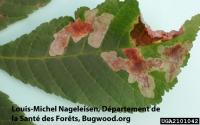
|
- Broadleaved, mixed and yew woodland
|
- Aesculus (Horse Chestnut)
|
Forestry Commission fact page
Observatree fact page
RHS fact page
Woodland Trust fact page
|
|
Large Brown Pine Weevil (Hylobius abietis)
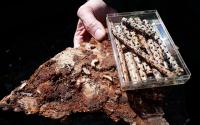
|
- Bogs
- Broadleaved, mixed and yew woodland
- Coniferous woodland
- Montane habitats
|
|
Forest Research fact page
Forestry Commission fact page
CABI data sheet
|
|
Larger Eight-toothed European Spruce Bark Beetle (Ips typographus)
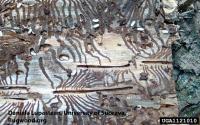
|
- Bogs
- Broadleaved, mixed and yew woodland
- Coniferous woodland
- Montane habitats
|
|
NOTIFIABLE ORGANISM
Forestry Commission fact sheet
DAERA fact page
CABI data sheet
UK Government guidance
|
|
Lophodermium Needle Cast (Lophodermium seditiosum)
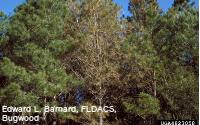
|
- Bogs
- Broadleaved, mixed and yew woodland
- Coniferous woodland
- Montane habitats
|
|
Cornell University fact page
Diseases and Disorders of Forest Trees (by S.C. Gregory and D.B. Redfern, 1998, Forestry Commission Field Book 16 )
Forest Pests fact page
University of Massachusetts Amherst fact page
|
|
Nematodes
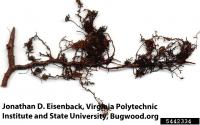
|
- Boundary and linear features
- Broadleaved, mixed and yew woodland
|
- Malus (Apple)
- Pine (Pinus)
|
Pine wood nematode is a NOTIFIABLE ORGANISM
Plantwise Knowledge Bank fact page (Dagger nematode)
University of Florida fact page (Dagger nematode)
Forestry Commission fact page (Pine wood nematode)
|
|
Oak Pinhole Borer (Platypus cylindrus)
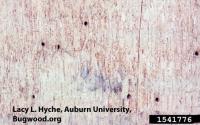
|
- Acid grassland
- Boundary and linear features
- Bracken
- Broadleaved, mixed and yew woodland
- Built up areas and gardens
|
- Castanea (Sweet Chestnut)
- Fagus (Beech)
- Fraxinus (Ash)
- Quercus (Oak)
- Ulmus (Elm)
|
Forest Research fact page
Forest Research fact sheet
|
|
Oak Processionary Moth (Thaumetopoea processionea)
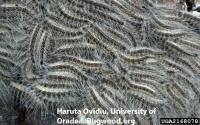
|
- Acid grassland
- Boundary and linear features
- Bracken
- Broadleaved, mixed and yew woodland
- Built up areas and gardens
|
|
NOTIFIABLE ORGANISM
CABI data sheet
Forest Research advice note
Forest Research fact page
Forest Research poster
Observatree fact page
Woodland Trust fact page
|
|
Oak Wilt (Ceratocystis fagacearum)
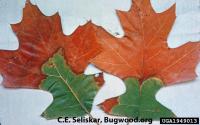
|
- Acid grassland
- Boundary and linear features
- Bracken
- Broadleaved, mixed and yew woodland
- Built up areas and gardens
|
|
NOTIFIABLE ORGANISM
DAERA fact page
Forestry Commission fact page
NRCS fact sheet
|
|
Oriental Chestnut Gall Wasp (Dryocosmus kuriphilus)
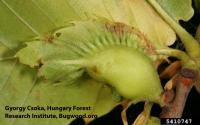
|
- Broadleaved, mixed and yew woodland
|
- Castanea (Sweet Chestnut)
|
NOTIFIABLE ORGANISM
Observatree fact page
Observatree toolkit
Forestry Commission poster
Royal Forestry Society article
|
|
Phytophthora alni
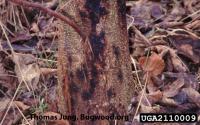
|
- Broadleaved, mixed and yew woodland
|
|
Forest Research fact page
Forestry Commission fact sheet
|
|
Phytophthora austrocedri
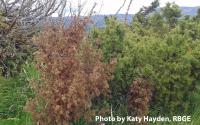
|
- Bogs
- Boundary and linear features
- Broadleaved, mixed and yew woodland
- Coniferous woodland
- Dwarf shrub heath
- Montane habitats
- Supralittoral rock
|
|
NOTIFIABLE ORGANISM
Forest Research fact page
Forest Research fact sheet
Forestry Commission fact page
Observatree fact page
|
|
Phytophthora pseudosyringae
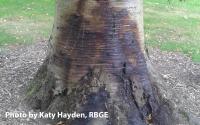
|
- Acid grassland
- Bogs
- Boundary and linear features
- Bracken
- Broadleaved, mixed and yew woodland
- Built up areas and gardens
- Calcareous grassland
- Coniferous woodland
- Dwarf shrub heath
- Inland rock
- Montane habitats
- Supralittoral sediment
|
- Quercus (Oak)
- Vaccinium (Bilberry, Cowberry)
- Tilia (Lime)
- Malus (Apple)
- Carpinus (Hornbeam)
- Alnus (Alder)
- Castanea (Sweet Chestnut)
- Fagus (Beech)
- Acer (Maple, Sycamore)
|
Forestry Research fact page
|
|
Phytophthora ramorum/kernoviae
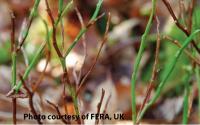
|
- Acid grassland
- Bogs
- Boundary and linear features
- Bracken
- Broadleaved, mixed and yew woodland
- Calcareous grassland
- Coniferous woodland
- Dwarf shrub heath
- Inland rock
- Montane habitats
- Supralittoral sediment
|
- Acer (Maple, Sycamore)
- Aesculus (Horse Chestnut)
- Arctostaphylos (Bearberry)
- Castanea (Sweet Chestnut)
- Fagus (Beech)
- Quercus (Oak)
- Vaccinium (Bilberry, Cowberry)
|
NOTIFIABLE ORGANISM
DEFRA fact sheet (Vaccinium symptoms)
DEFRA fact sheet (Vaccinium)
DEFRA fact sheet (P. kernoviae)
DEFRA fact sheet (P. ramorum)
DEFRA fact sheet (parks)
Forest Research fact page (P. ramorum)
Forestry Commission fact page (P. kernoviae)
RHS fact page
|
|
Phytophthora rubi
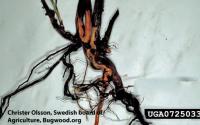
|
- Bogs
- Boundary and linear features
- Broadleaved, mixed and yew woodland
- Coniferous woodland
- Montane habitats
|
|
Pacific North West Pest Management Handbook fact page
|
|
Phytophthora siskiyouensis
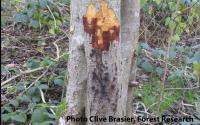
|
- Broadleaved, mixed and yew woodland
|
|
NOTIFIABLE ORGANISM
New Disease Report
|
|
Phytoplasmas
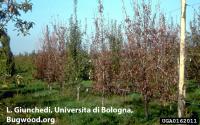
|
- Boundary and linear features
- Bracken
- Broadleaved, mixed and yew woodland
- Built up areas and gardens
- Calcareous grassland
- Improved grassland
- Inland rock
- Neutral grassland
- Supralittoral sediment
|
- Malus (Apple)
- Populus (Poplar, Aspen)
- Primula (Primrose)
- Prunus (Blackthorn, Damson)
- Rose (Rosa)
- Tilia (Lime)
- Ulmus (Elm)
|
Elm Yellows Phytoplasma is a NOTIFIABLE ORGANISM
Plantwise Knowledge Bank Fact Sheet Search (by phytoplasma name)
CABI Invasive Species Compendium Search (by phytoplasma name)
DEFRA fact page (Yellow Disease Phytoplasmas - Phytoplasma asteris)
DEFRA fact sheet (Pear Decline Phytoplasma - Phytoplasma pyri)
Forestry Commission fact sheet (Elm Yellows Phytoplasma - Phytoplasma ulmi)
Forestry Commission fact page (Elm Yellows Phytoplasma - Phytoplasma ulmi)
|
|
Pine Lappet Moth (Dendrolimus pini)
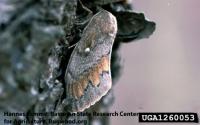
|
- Bogs
- Broadleaved, mixed and yew woodland
- Coniferous woodland
- Montane habitats
|
|
NOTIFIABLE ORGANISM
Forest Research fact sheet
Forestry Commission fact page
|
|
Pine Pitch Canker (Fusarium circinatum)
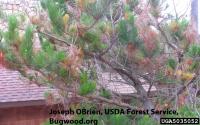
|
- Broadleaved, mixed and yew woodland
- Coniferous woodland
|
|
NOTIFIABLE ORGANISM
Forestry Commission fact page
Forestry Commission fact sheet
|
|
Pine Processionary Moth (Thaumetopoea pityocampa)
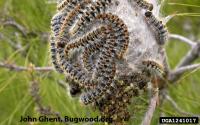
|
- Broadleaved, mixed and yew woodland
- Coniferous woodland
|
|
NOTIFIABLE ORGANISM
Forestry Commission fact page
Forestry Commission fact sheet
Forestry Commission poster
IMPACT fact sheet
Observatree fact page
OPAL fact page
|
|
Poplar Canker (Entoleuca mammata)
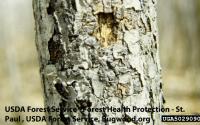
|
- Broadleaved, mixed and yew woodland
|
|
USDA fact sheet
Natural Resources Canada fact page
|
|
Viruses
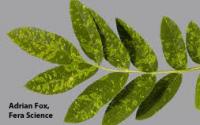
|
- Boundary and linear features
- Bracken
- Broadleaved, mixed and yew woodland
- Built up areas and gardens
- Calcareous grassland
- Coniferous woodland
- Improved grassland
- Inland rock
- Neutral grassland
- Supralittoral sediment
|
- Primula (Primrose)
- Prunus (Blackthorn, Damson)
- Rose (Rosa)
- Sorbus (Rowan)
|
Rose Rosette Virus and Tomato Black Ring Viruses are NOTIFIABLE ORGANISMS
Plantwise Knowledge Bank Fact Sheet Search (by virus name)
CABI Invasive Species Compendium Search (by virus name)
DEFRA fact sheet (Rose Rosette Virus - Rosa)
CABI fact page (Tomato Black Ring Virus - Prunus)
CERIS Purdue University fact sheet (Tomato Black Ring Virus - Prunus)
Observatree fact page (European Mountain Ash Ringspot Associate Virus)
Observatree guide (European Mountain Ash Ringspot Associate Virus)
FERA fact sheet (European Mountain Ash Ringspot Associate Virus)
RHS fact page (Impatiens necrotic spot virus - Primula)
DEFRA fact sheet (Plum Pox Virus - Prunus)
CABI fact page (Prunus Necrotic Ringspot Virus - Prunus, Rosa)
PNW Handbook fact page (Prunus Necrotic Ringspot Virus - Prunus, Rosa)
CABI fact page (Raspberry Ringspot Virus - Prunus)
CABI fact page (Tomato Ringspot Virus - Prunus)
PNW Handbook fact page (Arabis Mosaic virus - Rosa)
CABI fact page (Strawberry Latent Ringspot Virus - Rosa)
|
|
Xylella (Xylella fastidiosa)
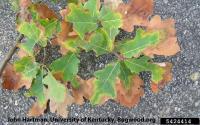
|
- Acid grassland
- Boundary and linear features
- Bracken
- Broadleaved, mixed and yew woodland
- Built up areas and gardens
|
|
NOTIFIABLE ORGANISM
Forestry Commission fact page
Forestry Commission pest alert
DEFRA fact page
|
|










































